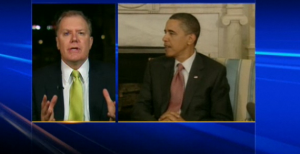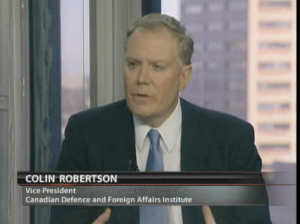Excerpted from John Ivison National Post Saturday, February 5, 2011 Canada could be a very different place
In his excellent new paper: “Now for the Hard Part: Renewing the Canadian-American Partnership,” former Canadian diplomat Colin Robertson offered some advice for Prime Minister Stephen Harper, on the eve of his departure for Washington to sign a new perimeter security deal with President Barack Obama.
He quoted Daniel Burnham, the great Chicago architect, who once said: “Make no little plans; they have no magic to stir men’s blood.” Mr. Robertson suggested that Mr. Harper should think big.
The new shared vision for perimeter security and economic competitiveness may not stir anyone’s blood, since it is in essence an agreement to seek future agreement. But make no mistake: The Beyond the Border declaration has the potential to take Canada to the next rung of economic integration with the United States.
The specifics revealed at the press conference in Washington were limited to bromides about the creation of a Canada-U.S. Regulatory Cooperation Council, which has been charged with the task of investigating why Cheerios on either side of the border have to have a slightly different formulation. But this deal is not solely consumed with ending the “narcissism of small differences” around regulation — it has the potential to be transformative for travellers, businesses and consumers
in ways that will be hailed by some Canadians and deemed unwelcome by others.
Mr. Harper acknowledged that the Washington declaration is a “starting point” for “an ambitious agenda.” He played down fears about Canada’s sovereignty being trampled by saying the deal is in the national interest.
Yet there’s no disguising the fact that if the border deal is carried to its logical conclusion, Canada will be a very different place than it is now.
On migration policy — possibly the biggest sticking point — the declaration states that the two countries will work together “to establish and verify the identities of travellers and conduct screening at the earliest opportunity.”
The intention is that fingerprints and retinal scans will become routine, leading to the evolution of an integrated entry-exit system, where entry into one country serves to verify exit from the other. This would require an unprecedented exchange of personal information.
The two countries already share watch-lists and passenger manifest lists for flights crossing each other’s airspace. But public opinion in Canada, already hardened by the Maher Arar case, may not welcome the sharing of more and more personal information with the Americans.
There was little detail available on how a perimeter security arrangement might work in practice, beyond a reference to increased cooperation across “air, land and maritime domains, as well as space and cyberspace.” This suggests that the NORAD joint air defence model may be adopted on land and sea. One practical example may be the emergence of joint customs facilities .
What else will it mean on the ground? Will Canada sign up to the Ballistic Missile Defence program that Paul Martin’s Liberal government snubbed? Will American ships patrol the Northwest Passage, which the U.S. considers an international waterway but Canada claims as an internal strait? If so, what does that mean for Mr. Harper’s Arctic sovereignty strategy?
In the run-up to a potential election, you might wonder why Mr. Harper is willing to risk the inevitable assault from the Left that he has sold the country’s soul for American gold. Liberal leader Michael Ignatieff foreshadowed his line of attack by saying the deal has the potential to “betray Canadian values.” But Mr. Harper’s motives are transparent: jobs.
When the Americans stepped up security at the border after 9/11, they exerted extreme pressure on Canada’s trade jugular. A look at the tourism statistics give some indication of the impact. In 2009, overnight visits from the U.S. totalled 11.7 million, down from more than 17 million in 2002.
On the business side, border congestion has interrupted just-in-time delivery for products manufactured on both sides of the border.
The Harper government finally resolved that it had to act and found a willing partner in Barack Obama, who has his own reasons for wanting trade to flow more freely, not least his stated ambition to double U.S. exports.
The potential for a deal was greatly improved by the comradeship apparent between the Prime Minister and the President, who have cooperated effectively on thorny issues ranging from the auto bailout to Afghanistan.
In the end, the enthusiasm on display in Washington Friday could quickly turn to ennui. The Security and Prosperity Partnership was launched with similar fanfare by George W. Bush, Mexican president Vicente Fox and then-prime minister Paul Martin in 2005. It was a similar, if more modest, package but did not survive the departure of its signatories.
Geoffrey Hale, a professor of political science at the University of Lethbridge, said that this declaration appears more substantive than anything we’ve seen in recent years. In his opinion, its success or failure will depend on whether Mr. Harper and Mr. Obama are truly committed to ensuring they get results from the various working groups charged with implementing the declaration. “The SPP died of analysis paralysis, administrative overload and the absence of political will,” he said.
The other hurdle to success will be convincing Canadians and Americans that the deal really is in their respective national interests. We already know that the opposition parties here are intent on debasing the debate to the level of partisan demagoguery.
But Mr. Ignatieff and his party would be well-advised to listen to one of their own before rushing to judgment.
As John Manley, the president of the Canadian Council of Chief Executives and a former Liberal deputy prime minister, put it: “Sovereignty is enhanced when prosperity is enhanced.”


